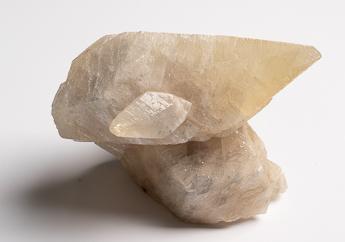
Calcite is deposited by solutions, either ordinary groundwater solutions or those related to the action of heated water in the earth’s crust. It is commonly associated with ore deposits and the cementing medium in sandstones. Even the lime deposit in the bottom of a teakettle, water heater or boiler is primarily calcite.

Crystals of calcite vary in size from microscopic to several feet in length and may weigh as much as several hundred pounds each. Some of the largest calcite crystals found in Missouri came from Crystal Cave, near Joplin, where they are called “glass tiff.” Crystal Cave was encountered during the mining of zinc-lead deposits in that area.
Calcite crystals occur in a variety of shapes. In Missouri, they frequently are elongated, sharply pyramidal crystals that resemble the teeth of a dog. Most calcite is colorless, white or pale amber. It is easily scratched with a knife and breaks readily into perfect rhombohedrashaped (six-sided) fragments. Transparent fragments exhibit the optical property of double refraction. For example, a pencil line viewed through the fragment will appear double.
Since calcite can have many appearances, the simplest way to determine if a mineral is calcite is to test its reaction to a dilute acid, such as vinegar. Calcite will readily react with acid by producing small bubbles of CO2 similar to those formed when you open a bottle of soda and pour it into a glass. Calcite uses are numerous. It is found in many everyday products such as shoe polish and bathroom cleaner, and it is in some foods and vitamin and mineral supplements. Calcite is used as an abrasive ingredient in toothpaste to provide cleaning power. It can be used in the manufacture of glass, paper, plastics, thermoplastics, rubber, ink, paint, whitewash, dyes, adhesives, coatings and sealants. Because calcite is in limestone, it is an important ingredient in mortar and Portland cement. Limestone used in the manufacture of lime has a wide range of uses including ag lime for agricultural purposes and quick lime for masonry jobs. It also is used for statuary and carvings, and as polished slabs used as facing stone for buildings. Considering the many uses of calcite, it is a mineral we could not do without.
Visit the department’s Ed Clark Museum of Missouri Geology, where you will find calcite on display.
